Common System 80 Expansion Options
The System 80 came with a number of expansion options. A suite of standard accessories were produced by EACA and sold via Dick Smith Electronics Ltd. A few third-party goodies were also popular expansion options.
1.0 Dick Smith Expansion Options
1.1 Expansion Unit
1.2 Disk Drives
1.3 Printer Interface and printers
1.4 Dick Smith Monitor
1.5 Fred sound/music synthesizer
1.6 "Sound Off!" package
1.7 300 baud duplex acoustic modem
1.8 Colour modification
1.9 Joystick adaptor kit
2.0 Third-party Expansion Options
2.1 Micro-80 Syspand Unit
2.2 Micro-80 Expansion Unit
2.3 System-80 Bus to TRS-80 Peripheral Cable
3.0 Third-party TRS-80 Accessories popular amongst System
80 owners
3.1 Exatron Stringy Floppy
3.2 Disk-80 Micromint Expansion Unit
3.3 General Northern Microcomputers Ltd. DP1000
1.0 Dick Smith Expansion Options
As with the TRS-80 Model 1, a set of "standard"
expansion devices were available to System 80 owners wishing to "grow"
their computers beyond the basic unit. These expansion options were not
cheap, in many cases being as much as the initial outlay of the computer
itself!
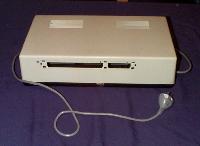 The
Expansion Unit was essentially a reasonably large non-descript rectangular
box which, like the TRS-80 one, sat at the back of the main unit and was strong enough to support
the monitor. It was cream coloured, to match the decor of the System 80
itself. The expansion edge had 50 pins on both the System 80 and
Expansion Unit, rather than the 40 found with the TRS-80 model 1. Like
the TRS-80, peripherals were connected by ribbon cables.
The
Expansion Unit was essentially a reasonably large non-descript rectangular
box which, like the TRS-80 one, sat at the back of the main unit and was strong enough to support
the monitor. It was cream coloured, to match the decor of the System 80
itself. The expansion edge had 50 pins on both the System 80 and
Expansion Unit, rather than the 40 found with the TRS-80 model 1. Like
the TRS-80, peripherals were connected by ribbon cables.
There were two versions of the Expansion Unit released. The original version (X4010) had a three-slot S100 bus backplane. The main board, in the top slot, had a floppy disk controller, I/O mapped printer interface and RS-232 serial interface. An extra 16 or 32 KB of RAM was normally included in the form of a s100 memory card (details here). Both the parallel port, and RS 232 were configured to use the I/O port addresses rather than the memory addresses as explained elsewhere on this site. This meant TRS-80 software using these devices often required patching to work. Alternatively, a simple hardware modification (detailed in the technical manual) could be done which made the printer interface available as a memory mapped device, like the TRS80 Model I, using a switch. The default disk controller was single density but a Percom doubler card was stocked by Dick Smith Electronics Ltd, and could be (and often was) added through a simple hardware modification.
The later version of the Expansion Unit (X4020) came out at the same time as the Blue-label model System 80. Internally it was completely different. The S100 bus was gone, along with the serial interface. The Printer interface was also now memory mapped as well as I/O mapped and no switch was required. The 32KB memory expansion was now on the main expansion unit board, and there was a 30-pin slot for the serial interface to be installed, along with a 50-pin extension of the expansion bus for custom cards. Assuming a doubler card was available, double density could be accomodated simply by plugging the card into the existing disk controller socket and moving a few jumpers (see a picture of a double-density card here). An S100 interface was available as a separate add-on. User and technical manuals for the X4020 can be downloaded here.
Detailed images of both expansion unit variants can be seen here.
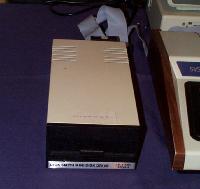 The
standard disk configuration was one or two Percom, Pertek or MPI 40 track
drives, again offered in a cream colour to match the decor (click here for a Dick Smith information sheet). The power
supplies were built into the drives. It came with a small
A5 installation guide.
The
standard disk configuration was one or two Percom, Pertek or MPI 40 track
drives, again offered in a cream colour to match the decor (click here for a Dick Smith information sheet). The power
supplies were built into the drives. It came with a small
A5 installation guide.
The DOS package sold with the System 80 disk option was one by Percom called OS-80 (which was actually Percom's TRS-80 MicroDos). It was inexpensive, and ok for a beginners DOS, but had no file handling routines or directory track. Most people soon dumped it for the more powerful TRS-80 DOS packages on the market at that time.
A technical manual for the MPI drives can be found here.
1.3 Printer interface and printers
 Dick
Smith Electronics Ltd also sold a simple printer interface (Cat. X-4012) for those who
simply wanted to be able to use a printer from a cassette based system.
The interface was a large card-like device, one end of which plugged into
the System 80 expansion bus, whilst the other end plugged into centronics
compatible printer such as the monster Itoh 8300P. See more in this Dick Smith information sheet.
Dick
Smith Electronics Ltd also sold a simple printer interface (Cat. X-4012) for those who
simply wanted to be able to use a printer from a cassette based system.
The interface was a large card-like device, one end of which plugged into
the System 80 expansion bus, whilst the other end plugged into centronics
compatible printer such as the monster Itoh 8300P. See more in this Dick Smith information sheet.
Another printer which appeared later on the scene was the Dick Smith X3252
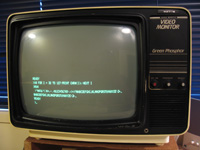 The System 80 could be plugged into a television but for some extra bucks Dick Smith was more than happy to provide a badged monitor too (Cat. X-1198). Essentially a small 12 inch television (of Asian origin) with the TV tuner removed, and composite and sound input jacks added. The light cream and black case suited the System 80 perfectly and many a unit was graced with these matching VDUs, which were either white or green.
The System 80 could be plugged into a television but for some extra bucks Dick Smith was more than happy to provide a badged monitor too (Cat. X-1198). Essentially a small 12 inch television (of Asian origin) with the TV tuner removed, and composite and sound input jacks added. The light cream and black case suited the System 80 perfectly and many a unit was graced with these matching VDUs, which were either white or green.
No manuals seem to exist on the web for this monitor but a circuit diagram can be found here.
1.5 Fred sound/music synthesizer
 The FRED sound/music synthesizer (Cat. X-3280) was available for the System 80 from around 1982. The device plugged into the System 80 expansion bus, and gave the computer a sound chip, namely the versatile General Instrument AY-3-8910. This was the same chip that was available on many arcade units, and cheap and cheerful home computers of the era. The successor to the System 80, the Colour Genie, had one.
The FRED sound/music synthesizer (Cat. X-3280) was available for the System 80 from around 1982. The device plugged into the System 80 expansion bus, and gave the computer a sound chip, namely the versatile General Instrument AY-3-8910. This was the same chip that was available on many arcade units, and cheap and cheerful home computers of the era. The successor to the System 80, the Colour Genie, had one.
Software (in BASIC) was available with the unit which allowed a user to program the chip. However although an interesting accessory, I know of no System 80 commercial games, from Dick Smith or otherwise, which used the device.
This manual provides some detail. The document is from Lowe Electronics, U.K.. It could be that this piece of hardware was developed by that firm, and license to Dick Smith to sell with the System 80. What appears to be an LE logo can be seen on the case. I’m unsure if the FRED Sound Synthesizer sold from Dick Smith stores looked like this, or if it was badged with the Dick Smith name. It could even be that EACA or a third party licensed the product to both Lowe electronics and Dick Smith. This hi-res photo shows the internals.
Incidently, the HT-1080Z, a Hungarian variant of System 80/Video Genie, had an AY-3-8910 sound chip built in!
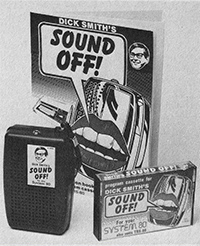 As mentioned above, the System 80 (like the TRS-80 Model 1) had no built-in sound chip. However, this didn't stop TRS-80 M1/System 80 game developers adding quite sophisticated sound effects (for the time), using the square wave output from the cassette port. Of course to hear these sounds, the cassette OUT port had to be connected to an amplifier. Early System 80 owners tended to use a television for a monitor. There was no sound input jacks on these early 1980s TVs so the Sound Off gadget did the job!
As mentioned above, the System 80 (like the TRS-80 Model 1) had no built-in sound chip. However, this didn't stop TRS-80 M1/System 80 game developers adding quite sophisticated sound effects (for the time), using the square wave output from the cassette port. Of course to hear these sounds, the cassette OUT port had to be connected to an amplifier. Early System 80 owners tended to use a television for a monitor. There was no sound input jacks on these early 1980s TVs so the Sound Off gadget did the job!
The original package contained the manual, a cassette tape with demo and "patch" software and the amplifier. Click to see photos of the amplifier cover and innards, and the original manual can be downloaded here. The manual had some sound routines users could type in to create their own sound effects, although I'm sure most just used the amplifier to enjoy whatever sound effects came with their favourite games.
Strangely, there were actually TWO versions of "Sound Off", each with the same catalogue number (X-3648). The second version of the package was minus the amplifier, and the manual was modified accordingly so the amplifier wasn't referenced specifically. This change may have occurred when Dick Smith started to sell The Dick Smith Monitor which had a suitable amplifier and sound input jack included.
The second version of the manual can be downloaded here.
1.7 300-baud-duplex-acoustic-modem
 This accessory (Cat. X-3270) allowed System 80 users to connect to on-line and bulletin board services via an early 1980s telephone handset. One end wrapped around the latter, while the other connected to the RS-232 port of the computer. Digital signals were converted to audio and vice versa at a whopping 300-baud. Characters would appear on the screen at about the speed of a competent typist. Here is a Dick Smith blurb sheet on the product.
This accessory (Cat. X-3270) allowed System 80 users to connect to on-line and bulletin board services via an early 1980s telephone handset. One end wrapped around the latter, while the other connected to the RS-232 port of the computer. Digital signals were converted to audio and vice versa at a whopping 300-baud. Characters would appear on the screen at about the speed of a competent typist. Here is a Dick Smith blurb sheet on the product.
I used a similar aucostic modem with my own System 80 with to communicated with my University's PRIME minicomputer from home - also at 300 baud! It worked just fine.
Note that the modem could also be used by the other 8-bit computer in the Dick Smith inventory at that time, the Exidy Sorcerer.
To promote this exciting accessory Dick Smith suggested tapping into MIDAS, an early on-line information service. It's promoted in this Dick Smith information sheet. The sheet is targeted at owners of the System 80 Mk II (the business system). I'm assuming this is because (1) the MkII had a terminal program in ROM (so no extra software was needed) and (2) only business owners could possibly afford the costs of going on-line those days! However I'm sure this modem could be used with a System 80 MK I or Blue Label if equipped with an RS-232 interface and suitable software.
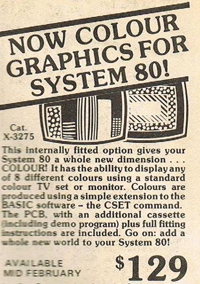 Late in the life cycle of the System 80, Dick Smith sold a third-party sourced internally-fitted colour graphics board (Cat. X-3275). Apparently Dick Smith ordered 200 of these from the supplier (maybe Lowe Electronics U.K.?), but just how many were sold is unknown. Personally I've never seen one, or a System 80 with one fitted.
Late in the life cycle of the System 80, Dick Smith sold a third-party sourced internally-fitted colour graphics board (Cat. X-3275). Apparently Dick Smith ordered 200 of these from the supplier (maybe Lowe Electronics U.K.?), but just how many were sold is unknown. Personally I've never seen one, or a System 80 with one fitted.
If anyone has anymore information on this modification please get in touch.
 Like its TRS-80 counterpart, the System 80 had no joystick port. Most games made use of the "arrow keys" of the blue label model or their equivalents (ESC, Control, TAB and Backspace) in earlier ones. In contrast, many home computers and arcade systems pouring onto the market at the time used joysticks as the primary way to interact with arcade-type games. A joystick prevented the keyboard from taking a hammering and (arguably) provided better control of whatever was being moved.
Like its TRS-80 counterpart, the System 80 had no joystick port. Most games made use of the "arrow keys" of the blue label model or their equivalents (ESC, Control, TAB and Backspace) in earlier ones. In contrast, many home computers and arcade systems pouring onto the market at the time used joysticks as the primary way to interact with arcade-type games. A joystick prevented the keyboard from taking a hammering and (arguably) provided better control of whatever was being moved.
Dick Smith sold a joystick adaptor kit (Cat K-3455) which, once assembled, plugged into the System 80 expansion port giving the computer a plug-and-play joystick port suitable for an Atari-type joystick. No driver software was required.
Interesting, this joystick interface appears to be the same one as that described in this article from Electronics Today International (ETI) dated August, 1982. The drawing in the latter showing the assembled product looks exactly the same as that in the Dick Smith advertisement.
It should be noted that another do-it-yourself System 80 joystick build was described in a series of articles in Micro-80 magazine.
There may have been other standard expansion options offered through Dick Smith Electronics Ltd at the time. If anyone knows of any, please .
Setting up an expanded System 80, with it's numerous cables and cards could be a daunting task to the uninitiated! Bear in mind computers were not mainstream at this time. Realising this, Dick Smith produced this handy assembly guide.
2.0 Third-party Expansion Options
Although many would dream about it, expansion
through the Dick Smith route was often beyond the average System 80 owner.
Given this situation, many users looked for more compatible, novel and/or
less expensive gear. A small number of third-party firms built, or marketed
products to hang off the 50 pin System 80 Expansion bus. Chief amongst
these was Micro-80 products, a business associated with the
popular Australian '80 support magazine. Among the products listed
below, they also provided memory expansion and lower case upgrade kits.
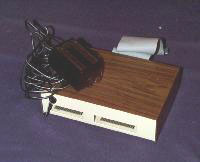 Finished
in a false wood grain and cream metal casing to match the decor, the Syspand
80 was a small self contained-cabinet (about 1/4 the size of an expansion
unit) that plugged into the 50 pin port of the System 80. It offered a
FULL TRS-80 Model 1 40 way bus as well as a centronics parallel printer
port. This was great for folk who wished to plug in TRS-80 compatible
expansion interface(s) and other goodies designed for the TRS-80 Model
1.
Finished
in a false wood grain and cream metal casing to match the decor, the Syspand
80 was a small self contained-cabinet (about 1/4 the size of an expansion
unit) that plugged into the 50 pin port of the System 80. It offered a
FULL TRS-80 Model 1 40 way bus as well as a centronics parallel printer
port. This was great for folk who wished to plug in TRS-80 compatible
expansion interface(s) and other goodies designed for the TRS-80 Model
1.
The printer port still used the standard System 80 I/0 port calls rather than the TRS-80 memory mapping so, like the printer port in the expansion interface, program patching was still often required.
The Syspand unit had it's own power supply,
which added to the spaghetti jungle of cables that disk-capable machines
usually found themselves coping with. The manual
is included on this site, as are hi-res images of the top side and bottom side of the circuit board.
In 1984 Micro-80 offered their own System
80 expansion unit, followed soon by an integrated unit with disk drives
included (called the '80 XT expansion). Here is the user manual. I'm not sure how many of these
sold. The System 80 was getting long in the tooth by this stage and had
been well-eclipsed by the C64 in the home market and PC's in the business
world.
2.3 System-80 Bus to TRS-80 Peripheral Cable
Can't get a Syspand Unit and want to connect TRS-80 Model 1 hardware? How about a simple cable? Here is the pin assignment. This piece of hardware was originally designed to interface a System 80 with a TRS-80 Model 1 compatible disk controller and printer port expansion box called a DP1000, which is described below. According to Knut Roll-Lund (a hardware wizard with these machines), this cable should be ok to be used with the TRS-80 Expansion Interface too PROVIDING you are not expecting it to carry RAM expansion signals as well. Then there might be a problem. However most System 80s had RAM expanded internally and if this is the case it shouldn't be an issue.
Like the Syspand unit, for a printer to work from a TRS-80 Model 1 expansion box with this cable, the printer code or hardware itself may need patching. My Stringy Floppy unit works with it well, so it may be ok for many of those TRS-80 Model peripherals that were designed to plug into the expansion port.
3.0 Third-party TRS-80 Accessories popular amongst System 80 owners
With a Syspand unit, or by wiring a cable
with a System 80 50 pin connector at one end and a TRS-80 40 pin connector
at the other, System 80 fans could avail themselves of the many TRS-80
accessories.
 The
Exatron Stringy Floppy (ESF) was an inexpensive option for high speed
storage (err...higher than cassette tape at any rate) without the expense
of going to a disk-based unit. The unit was produced by Exatron Corporation,
181 Commercial Street,Sunnyvale, CA 96086, USA. In Australia a company called ASP Microcomputers sold and supported the units, and even produced their own stringy floppy newsletter.
The
Exatron Stringy Floppy (ESF) was an inexpensive option for high speed
storage (err...higher than cassette tape at any rate) without the expense
of going to a disk-based unit. The unit was produced by Exatron Corporation,
181 Commercial Street,Sunnyvale, CA 96086, USA. In Australia a company called ASP Microcomputers sold and supported the units, and even produced their own stringy floppy newsletter.
The unit consisted of a small drive, designed to read and write to wafers of continuous tape. These wafers, about the size of a credit card (well..a couple of credit cards stacked on each other), were read at very high speed. What could take 10 minutes with tape would take 10 seconds with an ESF. What's more, the unit would work with 16k RAM (disk needed at least 32k), and ESF operating system was firmware, built into the unit and using some of the unoccupied RAM between the 12K ROM and the start of free memory at 4300H. This means cassette-based programs did not need to be offset, as they did in disk-based system, where the free memory started at 5200H. As a bonus, a keyboard de-bounce routine was in the ESF ROM curing cassette-based units of this keyboard plague.
The units were initialised from cassette basic by typing SYSTEM, then /12345 <new line>. After that, you could use the commands @load , @save to access files on the tape etc.
The ESF was a popular option. However, it wasn't a perfect solution. Wafers wore out eventually (sometimes rather quickly), leading to parity errors and occasionally the ESF would eat a wafer, resulting in a noise which was horrible to hear. Then it was all hands to the tweezers to extract the thin tape from the innards of the machine.
 The
wafers came in a number of different lengths and the 50' ones in particular
would be prone to failure (or being eaten). Users always kept their original
software on cassette tape...just in case.
The
wafers came in a number of different lengths and the 50' ones in particular
would be prone to failure (or being eaten). Users always kept their original
software on cassette tape...just in case.
I owned one of these units so know a lot about them. It still lies boxed up with my original System 80.
The ESF was eventually eclipsed as disk drives became more standard and expansion costs fell. However, it lives again in emulation and virtual wafers for the ESF can be downloaded from this page . A scanned 1980 manual is available here, or alternatively check out this 1982 one, which also covers use on the TRS-80 Model III.
3.2 MicroMint Disk-80 Expansion Unit
The MicroMint Disk-80 Expansion Unit was a third-party expansion unit for the TRS-80 Model 1. To tell the truth I'm not sure just how popular they were with System 80 owners, but they were available to Australians so I suspect a few folk had one of these hanging off their computers. The manual for this expansion unit (courtesy Dirk Stoffels, Canberra) is available here.
3.3 General Northern Microcomputers Ltd. DP1000
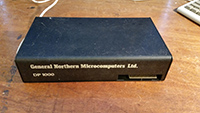 The DP1000 from U.K. company General Northern Microcomputers Ltd. was another third-party expansion unit. It came in two variants; one for the TRS-80 Model 1 using a 40 pin expansion bus and the other for the Video Genie (aka System 80) using a 50-pin bus. It provided a floppy disk interface and a parallel printer port. However, unlike the disk expansion units described above, the DP1000 had no onboard RAM. It was designed therefore, to be used with Model 1s and Video Genies which had internal RAM expansions. The latter was a common modification with the latter machines, allowing 48k without the huge expense of an expansion unit. Actually having 48k RAM under the keyboard made for a more reliable system rather than having the computer access 32k of it via an expansion cable, as in the standard setup.
The DP1000 from U.K. company General Northern Microcomputers Ltd. was another third-party expansion unit. It came in two variants; one for the TRS-80 Model 1 using a 40 pin expansion bus and the other for the Video Genie (aka System 80) using a 50-pin bus. It provided a floppy disk interface and a parallel printer port. However, unlike the disk expansion units described above, the DP1000 had no onboard RAM. It was designed therefore, to be used with Model 1s and Video Genies which had internal RAM expansions. The latter was a common modification with the latter machines, allowing 48k without the huge expense of an expansion unit. Actually having 48k RAM under the keyboard made for a more reliable system rather than having the computer access 32k of it via an expansion cable, as in the standard setup.
The DP1000 shown here was the unit that made my own System 80 disk-capable. It was actually a TRS-80 Model 1 variant but when used with a bus converter cable as described above, it performed very reliably. I purchased it from the Wellington System 80 user group, who imported a bulk lot of TRS-80 M1 DP1000s from the U.K. in 1984. They were suppose to get the Video Genie ones, but for some reason TRS-80 ones arrived instead.
For archive purposes, I've linked here pictures of the front and back of my TRS-80 M1 unit, along with a zip of photos of the circuit board from a Video Genie variant (provided by Antony Beagley, Auckland NZ). Strangely my unit had most of the chip labels scraped off! I can only assume this was to prevent rivals from reverse-engineering the boards and producing similar products.